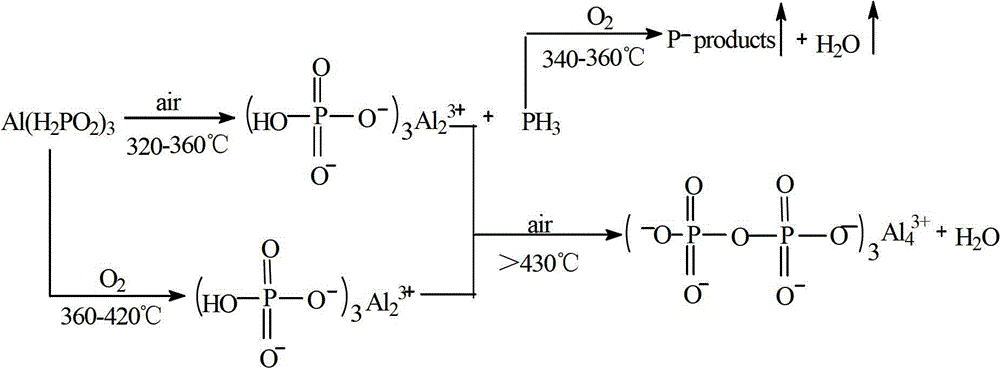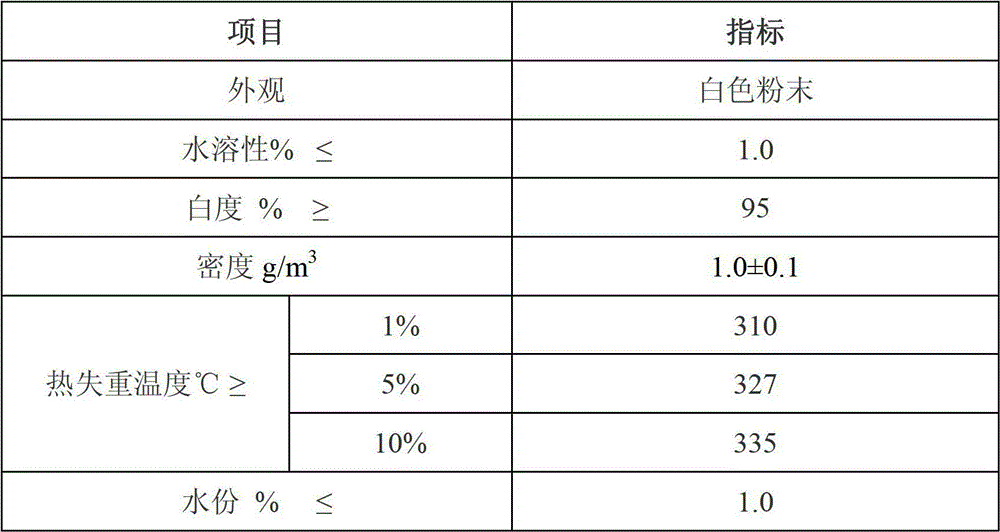Special environmental-friendly halogen-free flame retardant for ABS (acrylonitrile butadiene styrene) resin
A technology of ABS resin and flame retardant, which is applied in the field of phosphorus-based environmentally friendly flame retardants, can solve the problems of melting dripping and prohibition, and achieve the effect of good char formation, low price, and good flame retardancy
- Summary
- Abstract
- Description
- Claims
- Application Information
AI Technical Summary
Problems solved by technology
Method used
Image
Examples
Embodiment 1
[0017] Proportion (parts by weight): aluminum hypophosphite 15; melamine cyanurate 5; pentaerythritol 3; PE wax 2
[0018] Preparation method: Knead aluminum hypophosphite, melamine cyanurate, pentaerythritol and PE wax at a temperature of 85°C for 1.5 hours according to the above ratio.
[0019] Bromine antimony flame retardant (parts by weight): tetrabromobisphenol A: 18, antimony trioxide: 6
[0020] The application of the obtained product in ABS is as follows (the addition amount of the halogen-free flame retardant is 25wt%, and the addition amount of the bromine-antimony flame retardant is 24wt%):
[0021] In ABS (0215A), after using a twin-screw extruder to prepare a modified material, use an injection molding machine to inject a standard sample, and test its performance. The results are shown in Table 2:
[0022] Table 2 The flame retardant application test results in ABS
[0023]
[0024]
[0025] The experimental data show that the flame retardant has no big d...
Embodiment 2
[0027] Proportion (parts by weight): aluminum hypophosphite: 17; melamine cyanurate: 5; pentaerythritol: 3
[0028] Preparation method: Knead aluminum hypophosphite, melamine cyanurate and pentaerythritol according to the above ratio at a temperature of 85°C for 1.5h.
[0029] Bromine antimony flame retardant (parts by weight): tetrabromobisphenol A: 18, antimony trioxide: 6
[0030] The application of the obtained product in ABS is as follows (the addition amount of the halogen-free flame retardant is 25wt%, and the addition amount of the bromine-antimony flame retardant is 24wt%):
[0031] In ABS (0215A), after using a twin-screw extruder to prepare a modified material, use an injection molding machine to inject a standard sample to test its performance. The results are shown in Table 3:
[0032] Table 3 The flame retardant application test results in ABS
[0033]
[0034]
[0035] The experimental data show that the tensile performance of the flame retardant in ABS...
Embodiment 3
[0037] Proportion (parts by weight): aluminum hypophosphite: 17; ammonium polyphosphate: 5; pentaerythritol: 3
[0038] Preparation method: Knead aluminum hypophosphite, ammonium polyphosphate and pentaerythritol according to the above ratio at 85°C for 1.5 hours.
[0039] Bromine antimony flame retardant (parts by weight): tetrabromobisphenol A: 18, antimony trioxide: 6
[0040] The application of the obtained product in ABS is as follows (the addition amount of the halogen-free flame retardant is 25wt%, and the addition amount of the bromine-antimony flame retardant is 24wt%):
[0041] In ABS (0215A), after using a twin-screw extruder to prepare a modified material, use an injection molding machine to inject a standard sample to test its performance. The results are shown in Table 4:
[0042] Table 4 Application test results of the flame retardant in ABS
[0043]
[0044]
[0045] Experimental data show that the flame retardant in ABS has slightly different tensile ...
PUM
| Property | Measurement | Unit |
|---|---|---|
| limiting oxygen index | aaaaa | aaaaa |
Abstract
Description
Claims
Application Information
 Login to View More
Login to View More - R&D
- Intellectual Property
- Life Sciences
- Materials
- Tech Scout
- Unparalleled Data Quality
- Higher Quality Content
- 60% Fewer Hallucinations
Browse by: Latest US Patents, China's latest patents, Technical Efficacy Thesaurus, Application Domain, Technology Topic, Popular Technical Reports.
© 2025 PatSnap. All rights reserved.Legal|Privacy policy|Modern Slavery Act Transparency Statement|Sitemap|About US| Contact US: help@patsnap.com



